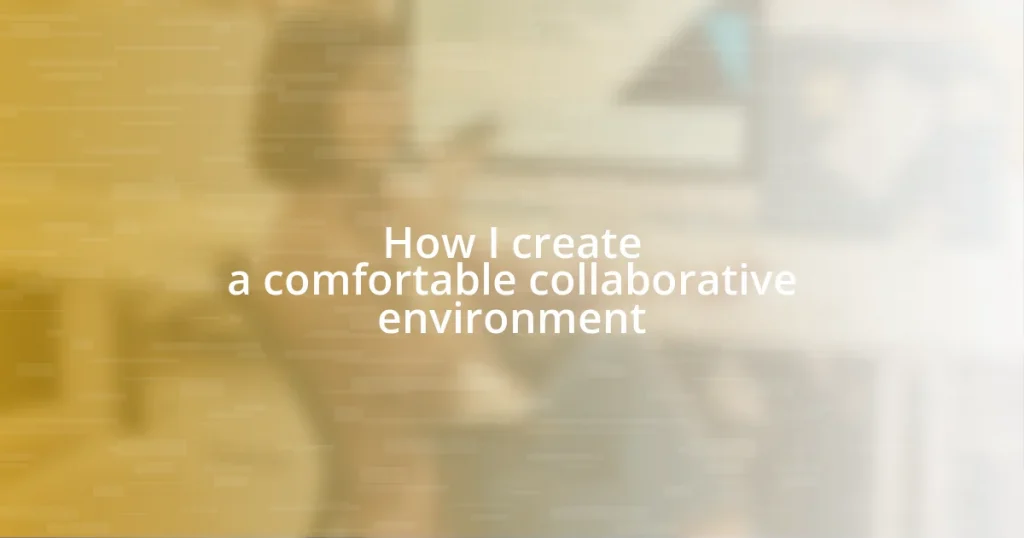Key takeaways:
- Collaboration thrives on diverse perspectives, emotional support, and fostering ownership among team members, transforming tasks into innovative solutions.
- Assessing team needs through direct conversations, team activities, and resource discussions uncovers deeper insights and enhances collaboration.
- Creating an inviting workspace, fostering open communication, and promoting diversity lead to a more engaged team and improved collaborative dynamics.

Understand the importance of collaboration
Collaboration is fundamentally about harnessing diverse perspectives to create better outcomes. I remember working on a project where each team member brought a unique viewpoint to the table. It was eye-opening to see how our collective strengths transformed what could have been a routine task into a truly innovative solution. Have you ever experienced that magic moment when brainstorming together leads to a breakthrough?
In my opinion, the emotional aspect of collaboration is equally crucial. When people feel valued and heard, it fosters trust and camaraderie. During a particularly challenging period in one of my teams, we established a weekly check-in that allowed everyone to share their thoughts and feelings openly. It not only alleviated stress but also strengthened our bond, achieving results we never anticipated. How do you nurture an environment where everyone feels comfortable sharing their ideas?
Finally, collaboration builds a sense of ownership and accountability among team members. I’ve witnessed how assigning roles based on individual strengths not only boosts confidence but also enhances productivity. When everyone feels responsible for the outcome, the entire team rallies together to achieve success. Isn’t it rewarding to see how collaboration transforms people from merely working together to truly thriving together?

Assess your team’s needs
To effectively assess your team’s needs, I find that it’s invaluable to engage directly with team members. I’ve had instances where merely sending out a survey led to surface-level responses. Instead, when I initiate one-on-one chats, I uncover deeper insights about what team members truly require for collaboration to flourish. This approach not only promotes openness, but it also allows me to tailor solutions to individual and collective needs, creating a more harmonious environment.
Additionally, understanding the dynamics within the team is essential. I recall a project where I noticed a couple of quieter members holding back during discussions. By facilitating activities that encouraged interaction, I found that these individuals had brilliant ideas waiting to be shared. This experience reinforced my belief that assessing needs isn’t just about what people say they need; it’s about recognizing the unexpressed needs that often surface in a more supportive context.
Lastly, I consider the resources available to my team. Sometimes the tools we think are useful can actually hinder productivity. I once introduced a new software solution without asking for input first, thinking it would streamline our workflow. Instead, it became an obstacle. By involving the team in discussions about resources, I’ve learned to select tools that genuinely enhance our collaborative efforts instead of complicating them. How have you navigated the balance between providing support and allowing autonomy in your teams?
| Assessment Method | Pros |
|---|---|
| Direct Conversations | Encourages openness and uncovers deeper insights |
| Team Activities | Fosters interaction and highlights unexpressed needs |
| Resource Discussions | Ensures tools meet team expectations and improve productivity |

Design an inviting workspace
Creating an inviting workspace has a significant impact on collaboration. I’ve discovered that color, lighting, and layout play pivotal roles. For instance, when I once redesigned my office, I opted for warm colors and plenty of natural light, which immediately transformed the energy in the room. Often, I notice team members gravitate towards areas that feel more inviting, sparking spontaneous discussions and creativity.
Here are some key elements to consider when designing an inviting workspace:
- Comfortable Furniture: Invest in ergonomic chairs and desks that accommodate different working styles.
- Personal Touches: Allow team members to personalize their spaces, fostering a sense of ownership.
- Collaborative Zones: Create areas specifically for group brainstorming or casual discussions, promoting interaction.
- Natural Elements: Incorporate plants or artwork that reflect nature, adding calmness and inspiration.
- Flexibility: Ensure the layout is adaptable, allowing for both collaborative work and quiet focus time.
One memorable experience I had involved adding a comfy lounge area with bean bags and soft cushions. The shift was almost immediate; I noticed a rise in informal meetings and brainstorming sessions happening there. It was a simple change that made the workspace feel more approachable, encouraging team members to connect more organically. Have you ever tried to analyze the impact of your workspace on your team’s dynamics?

Foster open communication practices
Building open communication practices within a team can transform collaboration, and I’ve seen this firsthand. In one project, I noticed that my team hesitated to voice concerns during meetings. So, I decided to implement a “feedback hour”—a dedicated time every week where team members would share thoughts on ongoing projects without the fear of judgment. This simple initiative allowed everyone to express their ideas freely, and I remember the excitement in the room when the quieter members began to share their unique perspectives. It made me realize that creating a safe space for dialogue is essential.
I also believe in fostering transparency by sharing not just the successes but also the challenges we encounter. There was a time when our team faced significant roadblocks on a project. Instead of glossing over these issues, I gathered the team to discuss them openly, encouraging a solution-focused mindset. I could sense a shift in morale; team members felt more invested in overcoming hurdles together. This shared vulnerability helped us bond and build trust, turning challenges into opportunities for growth. Have you ever considered how vulnerability can enhance your team’s cohesion?
Sometimes, integrating technology can improve communication practices dramatically. I introduced a team chat tool to encourage casual exchanges of ideas. Initially, some were skeptical, thinking it would distract from work. However, once we started using it for quick clarifications and celebrating small wins, it became a vital part of our communication. It reminded me of how important real-time interaction is, and I often found myself reflecting on the energy and engagement it inspired within the team. What tools have you found effective in nurturing open dialogue among your groups?

Implement effective team-building activities
Implementing effective team-building activities has been a game changer in my experience. I recall a time when I organized a fun outdoor retreat for my team to build trust and camaraderie. The day was filled with laughter as we navigated obstacle courses and engaged in team challenges. It amazed me how these activities broke down barriers, allowing team members to see each other in a new light, fostering connections that carried over into our daily work.
I’ve also found that mixing in some creativity with traditional team-building exercises can spark innovation. For instance, we once hosted a “design thinking” workshop, where team members collaborated on solving a real project challenge while using playful brainstorming techniques. The energy in the room was infectious! I could see the excitement on their faces as they built off each other’s ideas, ultimately leading to some brilliant solutions. Have you ever noticed how shifting the norm can lead to unexpected breakthroughs?
Additionally, regular team-building activities don’t always have to be elaborate. I often incorporate short icebreaker games at the beginning of our meetings. Something as simple as sharing a unique fact about oneself creates a relaxed atmosphere that makes everyone more engaged. One time, a quiet team member shared a remarkable story about their travels, igniting conversations that deepened our connections. Little moments like these transform the team dynamic and make collaboration feel effortless. How do you encourage team bonding in your own work environment?

Encourage diversity and inclusion
Encourage diversity and inclusion
Creating a culture that embraces diversity and inclusion has become a foundational principle of my collaborative environment. I recall when our team hired a new member from a vastly different background. Their unique perspective challenged some of our established norms, and it was enlightening to watch as they introduced fresh ideas that took our project in unexpected directions. This experience taught me first-hand that diverse voices contribute to richer outcomes; have you ever considered how a different viewpoint can elevate your team’s creativity?
To ensure everyone feels included, I make it a point to celebrate various cultural festivals and events within our workspace. For example, during Black History Month, I organized a sharing session where team members highlighted influential figures and their contributions. This not only deepened our understanding of one another’s backgrounds but also sparked meaningful discussions, drawing us closer together. I found it fascinating how even the simplest act of sharing stories can foster a sense of belonging. What celebrations have you woven into your team’s culture to promote inclusivity?
Moreover, I actively seek input from all levels of the team when brainstorming sessions arise. In one particularly dynamic meeting, I encouraged team members across different roles to voice their thoughts on a new initiative. I noticed that those who usually held back started sharing groundbreaking ideas that shifted the direction of the project entirely! This moment reinforced my belief that when everyone participates, we tap into a collective intelligence that transforms challenges into opportunities. Have you ever played the role of a facilitator to unlock hidden gems within your group?

Continuously evaluate and improve dynamics
Continuously evaluating and improving team dynamics is essential to maintaining a collaborative environment. I remember a time when we conducted a candid feedback session focused on our internal communication. It surprised me how openly team members expressed their thoughts. The discussions revealed gaps in our communication that we never recognized before. Have you ever uncovered insights in feedback that changed the way you work together?
As we implemented changes based on that feedback, I noticed an immediate shift in morale. Regular check-ins became a part of our rhythm, where we reflected on what worked and what didn’t. It was fascinating to watch the team actively engage in this process, taking ownership of our dynamic. I’ve learned that creating an ongoing dialogue can transform how we interact. How often do you revisit team goals and dynamics to ensure everyone is on the same page?
Integrating new tools has also played a significant role in enhancing our collaboration. When I introduced a project management software, it felt like opening a window to fresh air. It enabled transparency in our tasks and made it easy for everyone to track progress. The excitement amongst the team was palpable, and I found myself motivated by our collective drive toward improvement. Have you ever experienced the thrill of adopting a tool that made working together more seamless?















